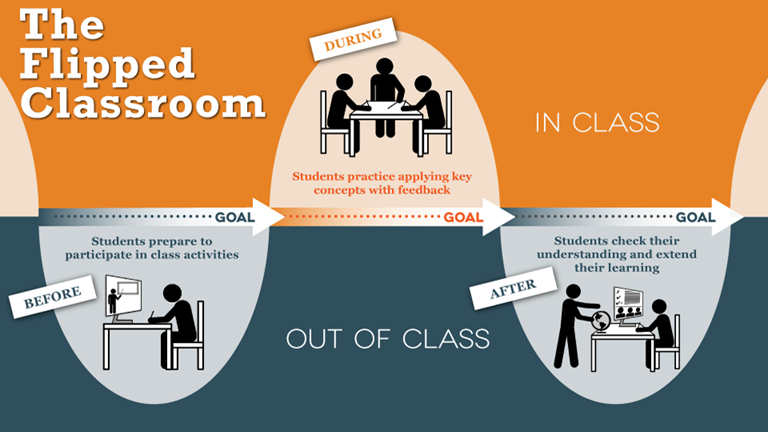What is a Flipped Classroom?
In a flipped classroom, students first engage with new course material before class—typically through videos, readings, or other self-paced resources. Then, during in-class time, they participate in collaborative, active learning activities to apply, analyze, and deepen their understanding with guidance from the instructor.

Why Use a Flipped Classroom?
The flipped classroom model offers several benefits for both students and instructors:
Promotes active learning and student engagement
Encourages self-directed learning and time management
Frees up class time for higher-order cognitive tasks (e.g., analysis, application, synthesis)
Supports differentiated instruction and peer collaboration
Enables efficient content delivery by allowing instructors to reuse and refine pre-class materials
How to Implement a Flipped Classroom
There’s no one-size-fits-all model. Even small changes—like adding active learning or shifting some content delivery outside class—can make a difference.
Start by identifying course areas where students often need clarification or where class engagement is low. Consider flipping:
Lessons with activities that consistently get cut short.
Topics students typically struggle with, based on past performance.
Concepts where guided, in-class application would help learning.
To pilot, try flipping just one module before committing to a full redesign. If flipping the entire course, clearly explain the format and expectations in the syllabus.
Students’ first exposure to new material should happen before class via:
Videos (recorded or curated), narrated slides, podcasts, multimedia readings.
Assigned readings, digital modules, or primary sources.
Effective pre-class materials should be:
Manageable in length and level.
Aligned with in-class activities.
Designed with accountability (e.g., quizzes, assignments, guiding questions).
To promote engagement, include:
Guiding/reflection questions or key takeaways.
Pre-class quizzes or entry tickets to verify completion.
Hints about upcoming in-class tasks.
Use class time for deeper engagement through:
Problem-solving, case analysis, peer instruction, or group work.
Activities like think-pair-share, concept mapping, or debates.
Be ready to:
Address gaps in student understanding.
Provide immediate, targeted feedback.
Adapt activities based on student progress.
Choose methods that align with your learning goals and disciplinary norms.
Help students consolidate learning with post-class tasks such as:
Online discussions or follow-up problems.
Assignments applying knowledge to new contexts.
Peer-led study groups or collaborative reflection.
Key design questions:
What in-class prep do students need for post-class success?
How do in-class and after-class tasks connect?
How does this sequence support your broader course objectives?
Common Challenges and Solutions
Challenge | Strategy |
|---|---|
Students don’t prepare | Use pre-class quizzes or reflective tasks with points; keep materials concise |
Resistance to format | Explain benefits clearly; share student success stories; scaffold gradually |
Uneven participation | Use structured group roles and frequent check-ins |
Time-consuming prep | Reuse existing resources or use open educational materials (OER) |
Resources
CTL Flipped Classroom guide (with examples): Flipped Classroom.pdf | Powered by Box


